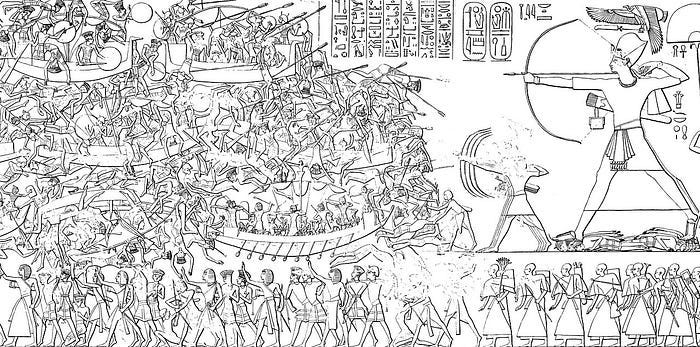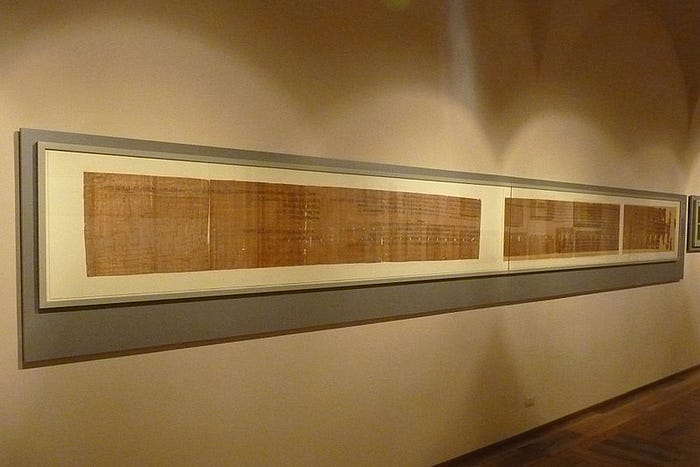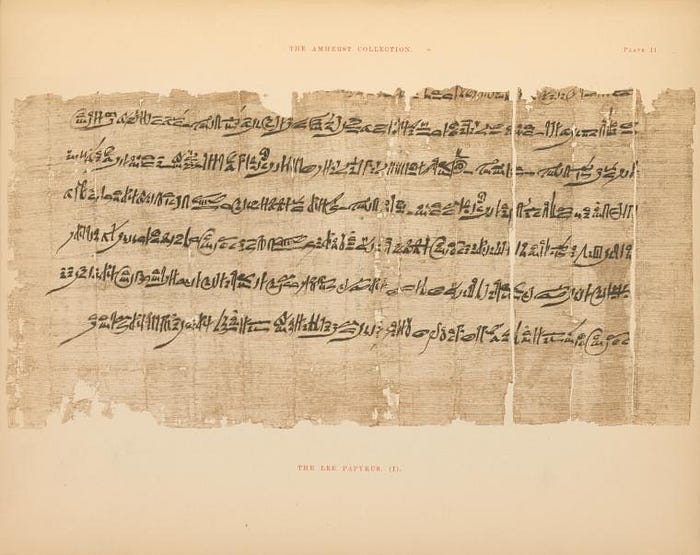Royal Conspiracy: A Pharaoh’s Assassination And The Epic Trial That Followed
How a scheme started in a harem caused the end of Ramses III

I want you to imagine a vision of the world for a second. War spreads over distant shores, threatening to destabilize the global order and international relations. Mass movements of refugees overwhelm borders. On top of everything else, an assassin throws domestic politics into turmoil.
The events above could come out of today’s headlines, but they also bear a striking resemblance to the position Egypt found itself in during the Bronze Age collapse.
Historian Eric H. Cline, in 1177 B.C. The Year Civilization Collapsed, compares this time to a broad systems collapse in which multiple issues, such as earthquakes, famines, droughts, and mass movements of people, caused the political hierarchy of the world to shake apart.
While powerful civilizations like the Myceneans and Hittites fell, a competent Pharaoh named Ramses III ruled his kingdom for over thirty years, fending off a series of invaders, only to fall victim to palace intrigue.
The monarch was assassinated by a cabal within his royal court involving one of his wives and his son. The event ended in a failed coup attempt, resulting in the conspirators' trials. Egyptian scribes also kept records of the proceedings that exist today.
The available texts describing the trial and the associated archeological fieldwork give us a unique view into a sensational event in ancient Egypt and its impact. Modern science has also corroborated some of the historical records. Consider it CSI: Ancient Egypt.
But before we can get to the conspiracy, the trial, and the aftermath, we should briefly examine Ramses III and the Egypt that existed in his day to give us perspective.
A Warrior, Administrator, And Trader
According to the Encyclopedia Britannica, Ramses III ruled Egypt from 1187 to 1157 BC. Into the fifth year of his reign, a group of Libyan tribes invaded Western Egypt, which the pharaoh repelled. Only two years later, a coalition the Egyptians referred to as the Sea Peoples attacked after the destruction of the Hittite Kingdom. This migrating group is thought to be one of the contributing factors of the Bronze Age collapse.

The pharaoh’s armies defeated these invaders on sea and land, but the remainder of these forces settled on the coast between Gaza and Mt. Carmel, checking any thought of Egyptian expansion. Within another two years, the Libyans attacked again.
After defeating the Libyans for a second time, Ramses III started vast building projects and even sent a trading mission to the land of Punt (a mysterious kingdom thought to be near Ethiopia, Somalia, and Eritrea.) He is also thought to have controlled copper mines in Sinai and possibly gold mines in Nubia.
By all accounts, he was a powerful monarch in an unstable time. However, his undoing started in a most unlikely place.
The Plot
Susan Redford, a professor of Classics at Penn State University, says a plot to overthrow the monarch emerged within the pharaoh’s harem. In her book, The Harem Conspiracy: The Murder of Ramses III, Redford says it started with the efforts of a secondary wife named Teya.
According to the trial records (which we’ll look at later), her son Pentawere wasn’t in immediate line for the throne, so Teya decided to remove Ramses III and seat her son. The conspiracy started small since the harem was removed from the outside world. Redford even refers to harem members as “inmates,” reflecting their sequestered status.
First, a chief of the royal pantry named Paibakamana was roped into the conspiracy, followed by butlers and scribes within the harem. The scheme eventually worked its way further into the royal court, enabling it to move from the harem to the royal court and into greater Egypt.
The overseer of the royal cattle herds also got involved (Redford thinks he may have been using cattle as bribes), as did an administrator of the treasury, the pharaoh’s doctor, and finally, a general named Pasai and a military commander named Bonemwese. It appears the plot was designed to attack the court and simultaneously cause uprisings in the land.
Even the court magician was involved. Remember, the pharaoh was considered a living god, so magic incantations would be needed to undo the ruler's heavenly protections.
While the plotters did succeed in killing Ramses III, the subsequent coup quickly fell apart, and the conspirators were apprehended. Now, you might be thinking: how do we know all this?
Fortunately, pieces of the trial transcript (or summary) still exist.
A Scandal-Filled Trial

Redford says the trial transcript was thought initially to be about twenty inches high and nearly sixteen feet long. Its discovery is a bit of a mystery. The scroll was in many antiquities. The French Consul-General of Egypt, Bernardino Drovetti, gathered it while in charge and then sold it to the King of Sardinia in early 1824.
At some point, a thief (or possibly agents working for Drovetti) cut this document into several pieces and sold them individually. Currently, there are six surviving sections. The largest piece is called the Judicial Papyrus of Turin and is in good condition.
Unfortunately, the separation has left some confusion about some aspects of the trial following the assassination. For instance, not every section is completely readable. Plus, two sections no longer exist, with only quick hand-copied versions of the original left, which were made by an explorer unfamiliar with the language.
While not entirely complete, Redford says these government documents appear to show a “carefully planned coup d'état” and notes that it must have been considered a “scandalous affair” that rocked the foundations of their society.
Although everyone indicted as a conspiracy member may not have been as deeply involved as others. Some of those executed or forced to commit suicide just knew of the plot and said nothing to authorities. Some convicted scribes just passed notes, while others looked up magic spells to use in the act.
Even the wives of the harem guards (who were executed for saying nothing) were executed as well because it was assumed they heard of the conspiracy and said nothing.

Redford—who translated the documents herself—lists over thirty names of conspirators brought before local magistrates to be tried. The trial also had some scandalous drama.
Some magistrates acting as judges and their bailiffs were found fraternizing with conspirators and punished (I’ll leave it for you to judge how they were being bribed). Redford provides a translation from the Judicial Papyrus of Turin:
“Persons punished by cutting off their noses and ears because they had forsaken the good instructions given to them. The women went and visited them in the place where they were. There they caroused with them and with Pasai. They were caught.”
In the end, most of the conspirators listed on the documents were either executed or forced to die by their own hands. This included the pharaoh’s son, Pentawere. However, there’s no mention of what happened to Queen Teya and the women of the harem.
But science has cleared up one mysterious aspect of the whole event.
The True Fate Of Ramses III
While the Judicial Papyrus of Turin states that members of the harem took part in an attempt on Ramses III’s life, it wasn’t known if he died before the trials started or during wounds received in the assassination attempt.
However, Egyptologist Dr. Zahi Hawass and a team of radiologists and biologists examined Ramses III’s mummy with a CT scanner and did some bone exams. According to their research paper:
“The CT investigation revealed a serious wound in the throat of Ramses III’s mummy, directly under the larynx. The injury was roughly 70 mm wide and extended to the bones (fifth to seventh cervical vertebra), severing all soft tissue areas in the anterior side of the neck. The trachea was clearly cut and its proximal and distal ends were retracted and separated by about 30 mm…”

This three-inch-wide cut was a mortal wound that no one could have survived. The team also found an object placed within the wound. It appeared to be an amulet, an Eye of Horus. The researchers believe the embalmers tried to dress up the mummy’s wound by implanting the amulet in the open space and then wrapping the neck with extra linen.
The team also scanned another unknown mummy found with Ramses III. This one was odd. It was a man between eighteen and twenty, and none of his organs were removed in the mummification process. The man was also covered in goat skin, which was rarely done because it was considered impure.
The researchers did a DNA test on the mummies, and the results strongly suggested the two were father and son. Hawass believes this unknown mummy is Pentawere. The impure burial may have been punishment for his role in the conspiracy, extending into the afterlife.
Ultimately, all this information gives us a unique view into an ancient world that seems far removed from us.
The Last Great Pharaoh
Ramses III could fend off foreign invaders that toppled many empires in his time, but he was eventually killed in the one space he thought was safe — his harem. Many refer to him as the last great Egyptian Pharaoh because Egypt declined after his death.
While we often refer to the times we live in now as “unprecedented,” one wonders what it would be like to be an Egyptian during this period.
Not only was a monarch thought to be a god assassinated, but his son took part in the plot. Not to mention many trusted members of the court.
A scandalous trial followed, in which judges may have been seduced by the pharaoh’s harem that took part in the assassination.
The world around them was collapsing, with the great empires comprising their trading partners falling one by one, not to mention Egypt declining before their eyes.
This must have been a nerve-wracking time to be alive, and we have a unique opportunity to see into this world from a three-thousand-year-old court transcript.
It makes me appreciate our chaotic times even more.
-Originally posted on Medium 10/9/24


